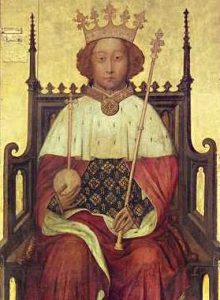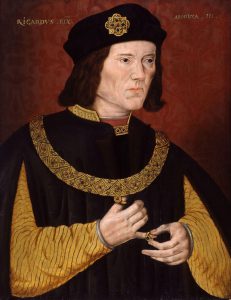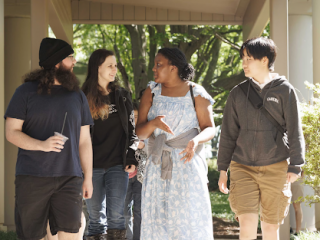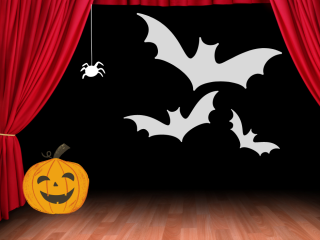While many English or Theatre teachers (myself included) embrace William Shakespeare’s Hamlet, Macbeth, or A Midsummer Night’s Dream, I actually really enjoy the history plays. Richard III is one of my favorite plays to teach because of the intriguing villain, dynamic poetry, and fascinating characters. However, in order for my students to make sense of it, I realized I had to make sense of the English history Shakespeare was using to write Richard III. In that endeavor, I tumbled down a rabbit hole and into a quagmire of complex English history mired in international and civil wars.
Most of Shakespeare’s history plays surround the Plantagenet Kings: Richard II, Henry IV Part 1, Henry IV Part� 2, Henry V, Henry VI Part 1, Henry VI Part 2, Henry VI Part 3, and Richard III. I learned early on three important concepts for success in reading these plays: First, a character could be referred to by his name or his title, so in the case of Richard, a character might refer to his first name, or to his title of “Gloucester”, the land where he ruled as Duke. � Secondly, medieval England operated under primogeniture, which meant that the estate and titles passed to the oldest male heir in the family. Finally, English ruling families reused names a lot–there are Richards, Henrys, and Edwards all over this family tree! With these rules in mind, let’s dig into Shakespeare’s Plantagenet kings.
(And a disclaimer: This is not meant to embrace all of the intrigues and nuances of English history or Shakespeare’s plays, but it is a starting point for understanding the complex history Shakespeare was working with.)
Edward III: The Beginning
Who were the Plantagenets? This particular line of kings descended from Edward III (1312-1377), a strong and formidable king. He had many children, but for our purposes, we’re interested in only three of them: Edward, the Black Prince; Edmund of York; and John of Gaunt, Duke of Lancaster. Edward was the oldest, and so was in line for the throne. His son Richard was born in 1367. Excellent, there is a stable lineage for the English throne! However, the Black Prince died in 1376, but Edward III died a year later. Which left little Richard, only nine years old, as the King of England.
Obviously, Richard (now Richard� II) was too young to rule by himself, so his uncles (especially John of Gaunt) guided him. When Richard was old enough, he assumed control. But no matter how good of a king he was, Richard’s reign was literally plagued with death and conflict: notably the Black Death and the Hundred Years’ War with France. But the final challenge Richard faced was his own family. John of Gaunt’s son Henry Bolingbroke had been exiled in France – which, it seems, was the place to be for an exile for the English nobility – and decided that he should be king. In 1399, Henry deposed his cousin and crowned himself Henry IV, and became the first Lancastrian King. Richard� II died in captivity, possibly from starvation.

The Lancasters Take Control
Now in charge, Henry IV continued the campaign to gain lands in France during the Hundred Years’ War. He didn’t do too bad, but his son, Henry V, decided to go after France with a vengeance. After the decisive battle of Agincourt in 1415 (memorialized in Shakespeare’s Henry V with the title character’s “St. Crispin’s Day Speech”), Henry’s legacy in France became stronger when he married Catherine of Valois (the daughter of the French king). They had one son, whom they named Henry. Because they repeated names. A lot.
Before Henry V could spend much time with his tot, he suddenly died in 1422 and the nine-month-old baby became king. As before, a council ruled until Henry VI could make decisions for himself. But Henry’s reign was tumultuous. He married a French woman, Margaret of Anjou, who was smart and shrewd and determined to keep her husband in power. But he didn’t make it easy for her ambitions. Henry VI suffered from bouts of madness, possibly schizophrenia, and legend has it that he did not even react to the news of his own son’s birth.
Throughout Henry VI’s reign, multiple families challenged his rule. One of those families was the Yorks, descended from Edmund of York (remember Edward III’s sons?), and they believed that they had a right to the throne. So, Richard of York began a fight against Henry VI, and after Richard died, his oldest son Edward of York took up the battle.
Now the kingship really gets muddled. While Henry VI is king, Edward of York deposes him and crowns himself Edward IV in 1461. But support rises up for Henry again, so Edward IV is deposed, and Henry is put back on the throne in 1470. Yet the fight is not over, and Edward IV ascends to the throne again in 1471. Henry VI dies in prison, possibly killed on Edward’s orders.
The Yorks Reign in England
Edward IV, a York, is now on the throne of England, what his brother Richard calls “the winter of our discontent” (at least at the beginning of Richard III). But Edward had been ill, and named his brother Richard, Duke of Gloucester, as Lord Protector of his son and heir, Edward, the Prince of Wales. When Edward IV dies, the boy (only 13 years old) becomes Edward V.
But before Edward can be officially crowned, Richard Gloucester collects the prince (and his younger brother, Richard, the Duke of York) and sends them to the Tower of London, apparently for protection. But Richard Gloucester begins restricting access to the “Princes in the Tower,” until July 1483, when they disappeared completely. Richard assumed the throne, and became Richard III, the last Yorkist king.

Richard III is one of the most maligned kings in English history–and Shakespeare definitely paints him in an evil light–but there is so much mystery surrounding his rise to power. Did he have his nephews killed? No one knows for sure, but the circumstantial evidence is strong. In any case, Richard was not very popular with some leading families and figures, particularly Henry Tudor, the Earl of Richmond. This Henry was a descendant of John of Gaunt, a Lancaster, and a rival to the York family.
The End of the Plantagenets
Henry Tudor raised an army in France and Scotland, and did gain support of some Yorkists, notably the widow of Edward IV and her family. In 1485, at the Battle of Bosworth, near the town of Leicester, the armies of Henry Tudor and Richard III met. Richard III was killed, the last English king to die in battle. For centuries, it was believed his body was lost to time, but in 2012, it was found under a parking lot.
Henry Tudor, a Lancaster, married Edward IV’s daughter, Elizabeth of York, thereby uniting the feuding families, ending the Wars of the Roses, and beginning the Tudor Dynasty. Their son became the notorious Henry VIII, and his second daughter became Elizabeth I, the monarch on the throne when Shakespeare wrote most of his history plays.
And that’s the abbreviated, speedy history of the early English monarchs!
A Quick Reference for the Plantagenet Players
The Original Plantagenets
Edward III 1312-1377
- Edward, the Black Prince 1330-1376
- Richard II 1367-1400
- Lionel of Antwerp, the Duke of Clarence 1338-1368
- John of Gaunt, Duke of Lancaster 1340-1399
- Edmund of York 1341-1402
The Lancasters
John of Gaunt 1340-1399
- Henry Bolingbroke, later Henry IV 1367-1413
- Henry V 1386-1422 (married Catherine of Valois in 1420)
- Battle of Agincourt in 1415 (in Shakespeare’s play)
- Henry VI 1421-1471 (became King at only 9 months old)
- Married Margaret of Anjou in 1445
- 1st reign from 1422-1461
- 2nd reign from 1470-1471
- Edward of Westminster 1453-1471
The Yorks
Richard of York 1411-1460
- Edward IV 1442-1483
- 1st reign from 1461-1470
- 2nd reign from 1471-1483
- Married Elizabeth Woodville in 1464
- Elizabeth of York 1466-1503
- Edward, Prince of Wales, later Edward V 1470-1483
- Richard of Shrewsbury, Duke of York 1473-1483
- Richard, Duke of Gloucester, later Richard III 1452-1485
The Tudors
Henry Tudor, Earl of Richmond 1457-1509
- Married Elizabeth of York















1 comment
Thanks. I have been trying to straighten this out. Need to rewatch the appropriate plays.